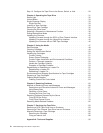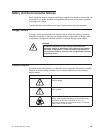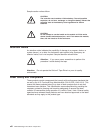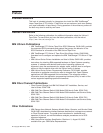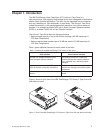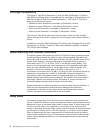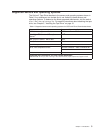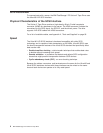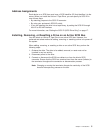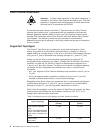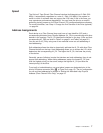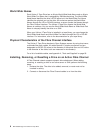
Cartridge Compatibility
The Ultrium 2 Tape Drive (Generation 2) uses the IBM TotalStorage LTO Ultrium
200 GB Data Cartridge and is compatible with the cartridges of its predecessor, the
IBM Ultrium Internal Tape Drive (called Generation 1). The Ultrium 2 Tape Drive
performs the following functions:
v Reads and writes Generation 2 cartridges to Generation 2 format
v Reads and writes Generation 1 cartridges to Generation 1 format
v Does not write Generation 2 cartridges to Generation 1 format
v Does not write Generation 1 cartridges to Generation 2 format
The Ultrium 2 Tape Drive reads tapes that have been written by other licensed
Ultrium 2 drives. It also writes to tapes that can be read by other licensed Ultrium 2
drives.
In addition to using the IBM TotalStorage LTO Ultrium Data Cartridge with up to 200
GB capacity, the Ultrium 2 Tape Drive also offers read/write capability for certified
LTO Ultrium tape cartridges.
Speed Matching and Channel Calibration
To improve system performance, the Ultrium 2 Tape Drive uses a technique called
speed matching to dynamically adjust its native (uncompressed) data rate to the
slower data rate of a server. With speed matching, the drive operates at one of five
speeds when reading or writing the Generation 2 cartridge format to achieve a
native data rate of 17.5, 21.9, 26.25, 30.63, or 35 MB per second (MB/s). If the
server’s net (compressed) data rate is between two of the preceding native data
rates, the drive calculates which of the two data rates at which to operate. (For
example, if the server transfers data at 60 MB/s on the host bus, at 2:1
compression its net data rate is 30 MB/s. The drive will then dynamically choose to
operate at a native data rate of 26.25 or 30.63 MB/s, whichever enables it to
successfully receive the greatest amount of compressed data over the network.)
Speed matching dramatically reduces backhitch, the condition that occurs when a
tape stops, reverses, and restarts motion. A backhitch is usually the result of a
mismatch between the data rates of the server and the drive.
System performance is further optimized by a feature called channel calibration,in
which the drive automatically customizes each read/write data channel to
compensate for variations in such things as the recording channel’s transfer
function, the media, and characteristics of the drive head.
Sleep Mode
To conserve energy when circuit functions are not needed for drive operation, the
Ultrium 2 Tape Drive features a power-management function that causes the drive’s
electronics to enter a low-power mode known as sleep mode. To enter sleep mode,
the drive must be inactive for a minimum of 15 minutes; to exit, the drive must
receive a command across the SCSI or Fibre Channel interface, a command across
the Library/Drive Interface (LDI or RS-422 interface), or a load or unload request.
When in sleep mode, the drive’s response time to commands that do not require
media motion increases by up to 10 microseconds. Commands that require media
motion may be delayed an additional 100 milliseconds because the tape must be
retensioned.
2 IBM TotalStorage LTO Ultrium 2 Tape Drive



